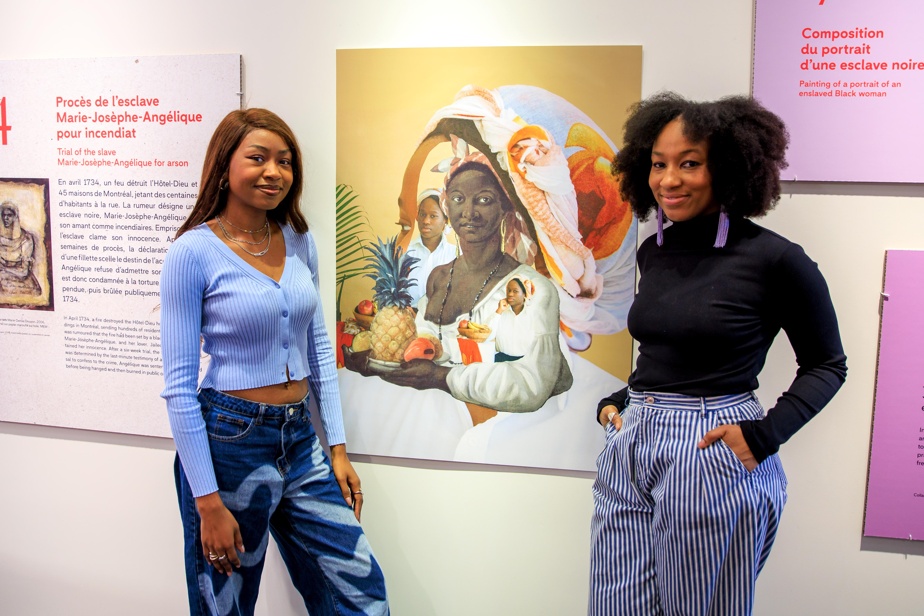Our journalist travels around Greater Montreal to talk about people, events or places that mark urban life.
Did you know that the Club of Colored Women of Montreal was founded in 1902? That McGill University held a conference of black writers in 1968? That it was in 1902 that the term “Chinatown” appeared for the first time in The Press ? That the natives have occupied the territory for 5000 years?
This is what you will learn in the captivating exhibition Between past and present: forgotten stories of Montrealpresented free of charge at the MEM – Center des memories montrealaises until April 18.
This project from the Je suis Montréal collective demonstrates the extent to which black, indigenous and Chinese people are erased in the history of Montreal with a capital H.
Taïna Mueth, co-founder of the collective, and Myriam Olmand, with whom she set up the exhibition, had just seen the final assembly in the glass wing of the MEM which overlooks the ice rink on the Esplanade Tranquille when we met. They had tears in their eyes. “I never thought this project would end up in a museum,” the first pinched herself. “All the work accomplished since 2020,” said the second.

PHOTO ALAIN ROBERGE, THE PRESS
Presented as part of Black History Month, the exhibition is free and the opening takes place Thursday evening.
Between the past and the present first took the form of a virtual exhibition in 2020, then was presented for a week at the WIP art gallery, boulevard Saint-Laurent, last year. The idea germinated in Taïna Mueth’s mind when she saw in the archives of the McCord Museum a portrait of Mary Ann Law Guilmartin, photographed by William Notman in 1877. She was struck by its elegance. But why had she never heard of her?

PHOTO ALAIN ROBERGE, THE PRESS
Mademoiselle Guilmartin was born a slave before marrying a deputy, and this photo gives her empowerment (empowerment), underlines Taïna Mueth.
“I wanted to give other people the feeling of finally seeing themselves represented in history,” explains Taïna Mueth. We existed and we have our place in the history of Montreal. Alexander Grant made things change, maybe me too,” says the one who is in charge of projects at the Fédération des femmes du Québec.
Give a voice
Who is Alexander Grant? Arriving from New York in 1830, he is considered the first black activist in Lower Canada. “He is a leading figure in the black community in Montreal,” says Myriam Olmand. He wrote in newspapers about the abolition of slavery. »

PHOTO ALAIN ROBERGE, THE PRESS
A collage of photographs by Alexander Grant
Between past and present: forgotten stories of Montreal is part of what the History Center did before becoming the MEM in a new space inaugurated last fall. “Giving a voice to groups that we hear less,” emphasizes Josée Lefebvre, responsible for citizen and community projects.

PHOTO ALAIN ROBERGE, THE PRESS
Josée Lefebvre, responsible for citizen and community projects at the MEM
It recalls the exhibition in 2007 on the trial of Marie-Josèphe-Angélique. This story of a slave accused – before being hanged – of a fire which destroyed the Hôtel-Dieu and 45 houses in 1734 is as fascinating as it is terrifying. “These are events perhaps known to historians, but not to the general public,” argues Mme Lefebvre.
It is also fascinating to learn that the Rockhead’s Paradise bar, opened in 1928 at the corner of Saint-Antoine and de la Montagne streets, was the first nightclub in Canada to be owned by a black businessman, Rufus Rockhead. Great jazz stars like Louis Armstrong, Billie Holiday, Nina Simone and Ella Fitzgerald sang there.
“We have already called the Little Burgundy district the Harlem of the North there was such a strong jazz culture and a wave of black immigration from the United States,” says Taïna Mueth, who would have liked to learn about it in a history class.

PHOTO ALAIN ROBERGE, THE PRESS
The exhibition has an artistic dimension with this collage by Bliss Mutanda (who reinvents history in front of Place D’Youville), as well as poems by Florence M. Rosalie, Maya Cousineau-Mullen and Bao-Vy Nguyen.
A lack of information
There are better known works by Frank Mackey and Dorothy Williams1 on the history of black Canadians, but too little on the indigenous and the community of Chinese origin, regrets Taïna Mueth.
Too few people know the Huron leader Kondiaronk, to whom we owe the Great Peace of Montreal. Others are unaware that a third of Chinatown was razed in 1970 for the construction of the Palais des congrès and the Guy-Favreau Complex (fortunately, it has just been classified as a historic site).

PHOTO ALAIN ROBERGE, THE PRESS
Activities are offered alongside the exhibition. On Saturday, archivists from Concordia University will give the public access to period photos.
The power of belonging
The Je suis Montréal collective was born with the distressing observation that many children of immigrants suffer from a lack of feeling of belonging even though they were all born here, recalls Taïna Mueth. The identities of the daughter of a Haitian mother and a Cameroonian father, who fell in love in Montreal, are multiple, and she embraces them all.
Myriam Olmand has “Montreal tattooed on her heart”, although she has also already felt lost in the definition of her identity. “I don’t have to fit into just one box. I am who I am,” says the woman who works in communications for the Cree Council of Health and Social Services of James Bay.
We wish them what they are well on their way to: making history after having remade it.
1. Dorothy Williams gives a lecture Thursday evening in Pointe-à-Callière as part of Black History Month.
Visit the exhibition page
